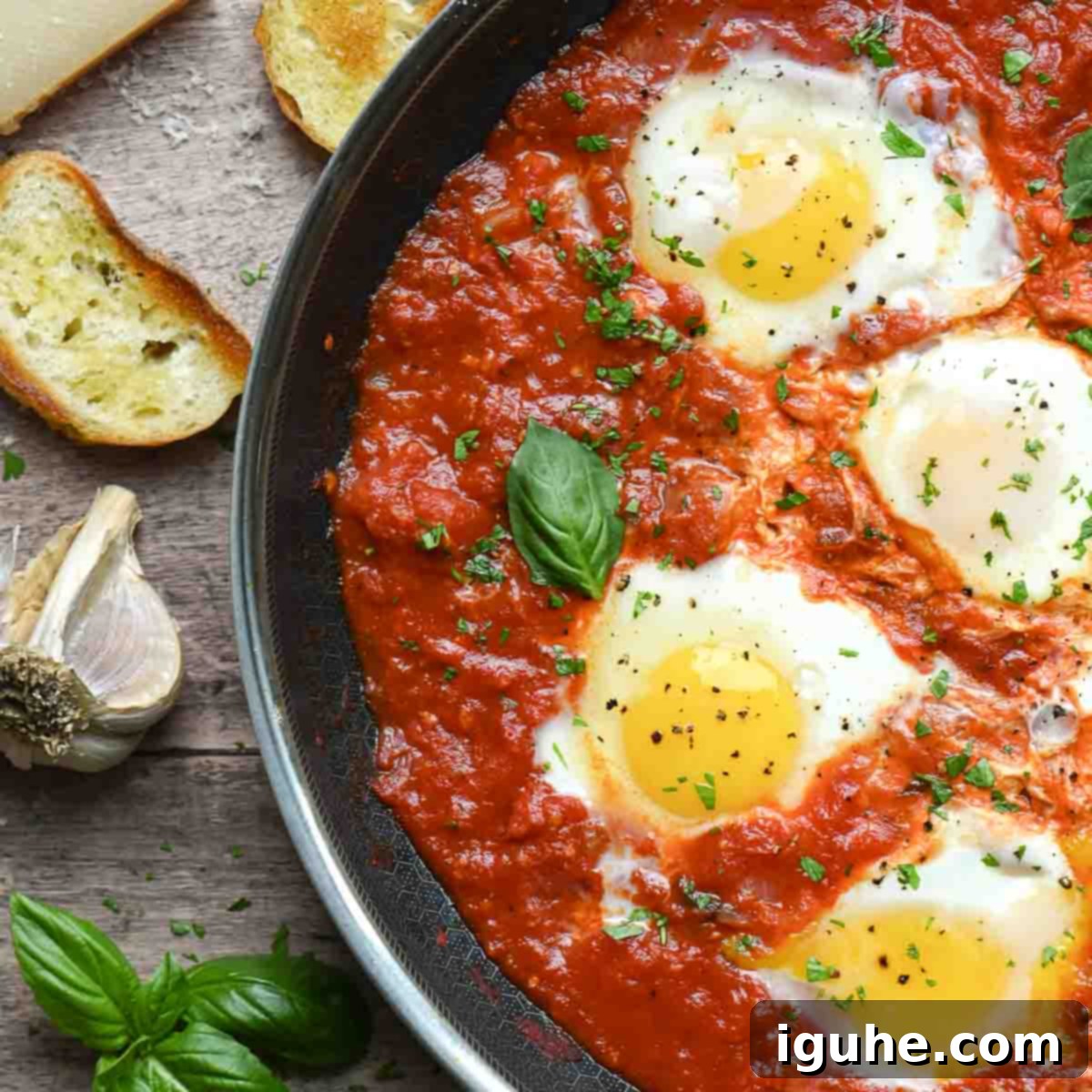Eggs in Purgatory: An Easy & Flavorful Italian Shakshuka Recipe (Uova al Purgatorio)
Eggs in Purgatory (Uova al Purgatorio) is a remarkably rustic yet elegant Italian dish that brings together the simplicity of poached eggs with a rich, aromatic tomato sauce. Despite its playfully dramatic name, this one-pan wonder is a truly versatile and incredibly satisfying meal, perfect for a cozy brunch, a quick weeknight dinner, or even a delightful appetizer. The essential companion to this saucy, eggy goodness? A generous serving of warm, crusty bread, ready to soak up every last drop of flavor!
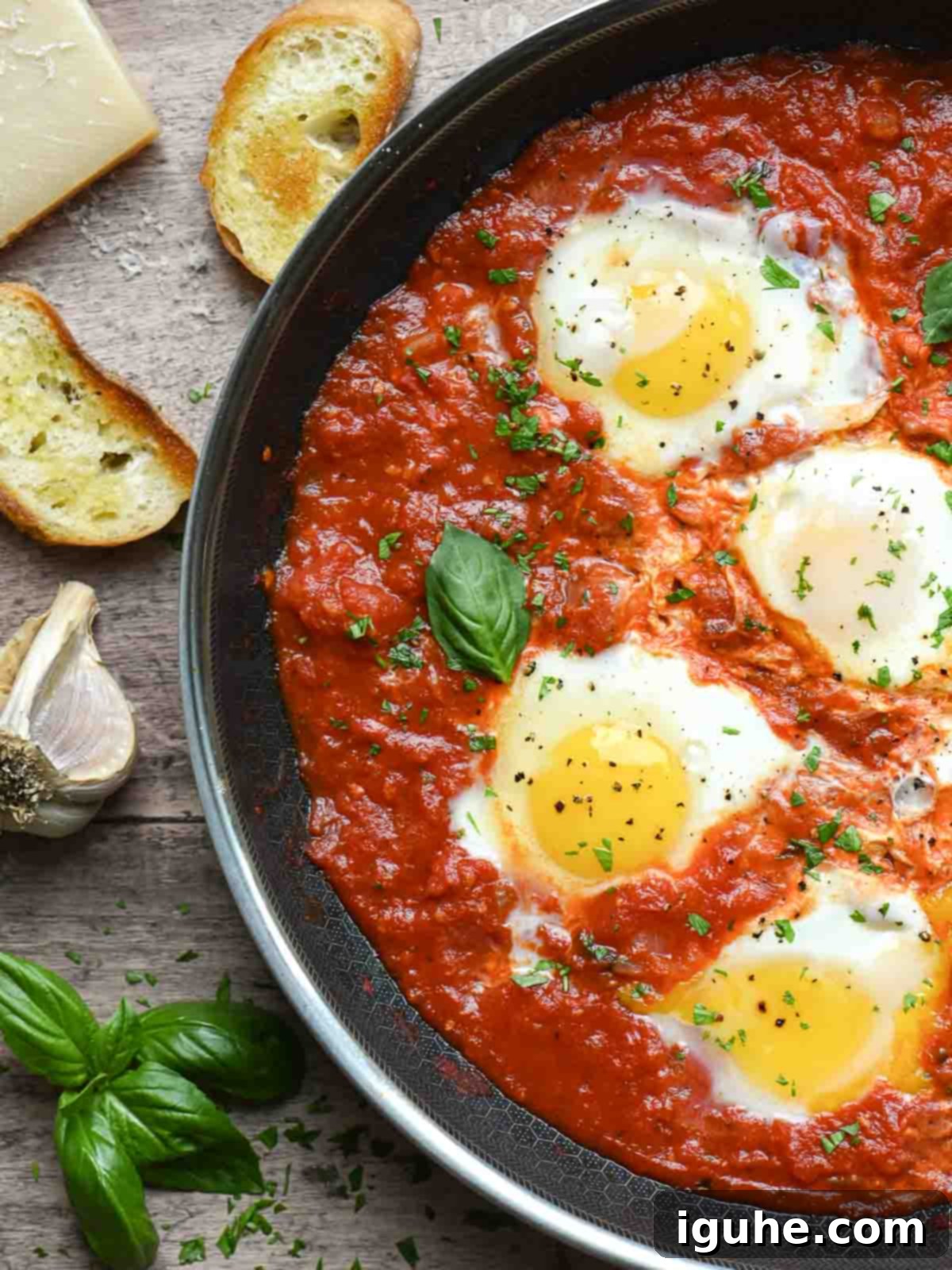
Often referred to as the Italian cousin to the popular North African and Middle Eastern dish, Shakshuka, Eggs in Purgatory shares its core concept: eggs gently cooked in a vibrant tomato base. However, the Italian version distinguishes itself with a more pared-down, traditional approach, often focusing on the pure flavors of quality tomatoes, garlic, onion, and fresh herbs. This simplicity is its strength, making it feel gourmet without requiring complex culinary skills. It’s a dish that warms the soul and satisfies the palate with minimal effort.
While Shakshuka typically features a bolder spice profile with ingredients like red peppers, cumin, paprika, and sometimes a fiery harissa, Uova al Purgatorio leans into the classic Italian pantry. It relies on the inherent sweetness of good quality canned tomatoes, the pungent aroma of fresh garlic, and the earthy notes of dried oregano and fresh basil to build a deeply satisfying and subtly spicy (if you choose) sauce. This makes it a fantastic option for those who appreciate traditional Italian flavors and a less complex, yet equally delicious, egg dish.
So, where does the intriguing name “Eggs in Purgatory” come from? It’s certainly memorable, evoking images far removed from a comforting brunch. The “wacky” moniker actually originates from the visual resemblance of the eggs, nestled in the simmering red tomato sauce, to souls suspended in the fiery, in-between state of purgatory. A dramatic metaphor, indeed! But rest assured, enjoying this dish will be a heavenly experience, not an existential one. In fact, you’ll likely find yourself craving its comforting embrace time and time again.
Key Ingredients for the Perfect Eggs in Purgatory
Creating this rustic Italian shakshuka requires just a handful of straightforward ingredients, most of which you likely already have in your pantry. The beauty of Eggs in Purgatory lies in its simplicity, allowing each core component to shine. Here’s a detailed look at what you’ll need to assemble this flavorful dish with minimal fuss.
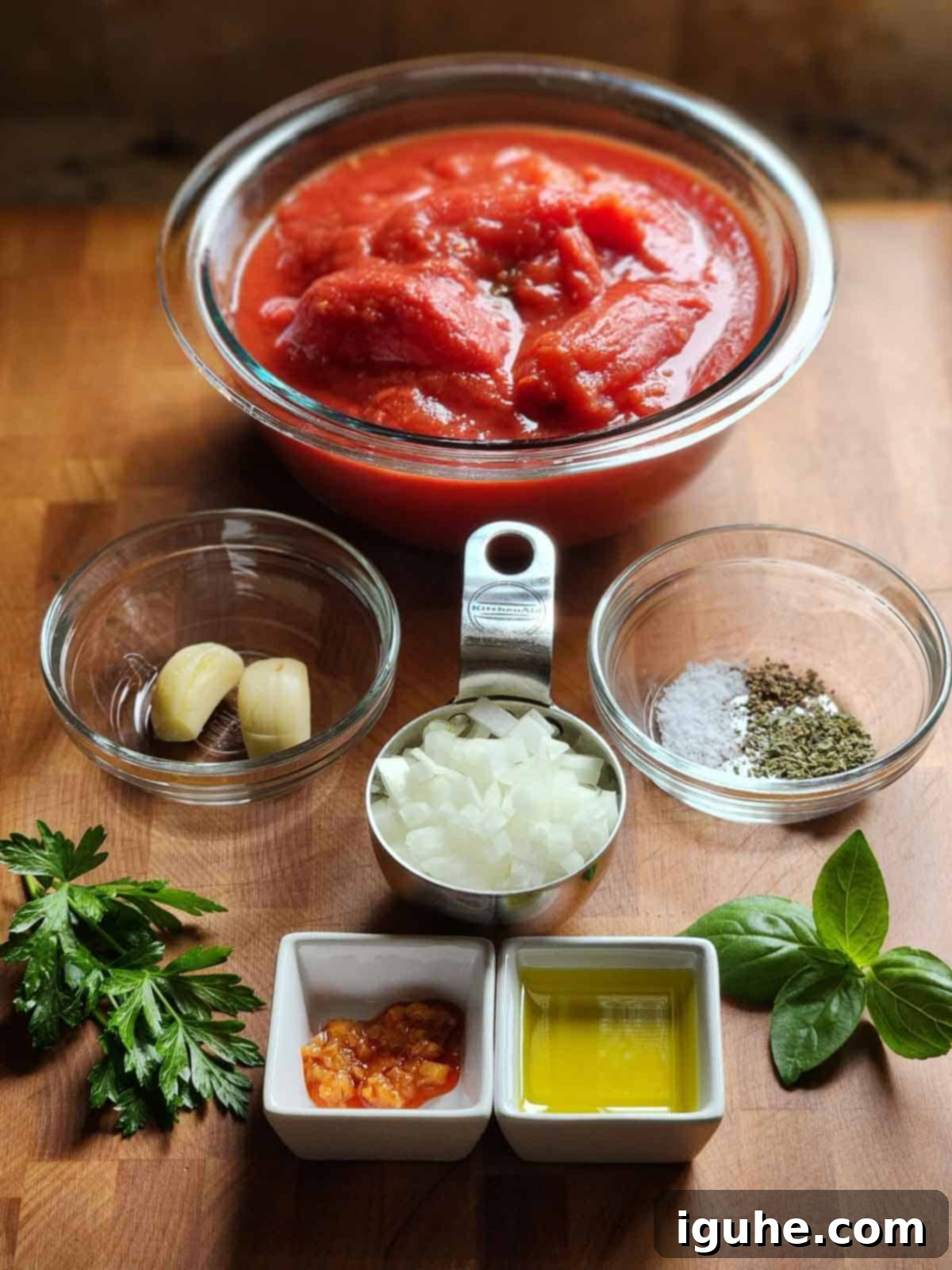
- Canned Tomatoes: The Heart of the Sauce
For the most authentic and robust flavor, opt for high-quality canned whole peeled tomatoes. While crushed or diced tomatoes are convenient, whole tomatoes, when crushed by hand, offer a superior depth of flavor and allow you to control the texture of your sauce precisely. San Marzano tomatoes, if available, are always an excellent choice for their sweet, balanced acidity. - Onions: Adding Sweetness and Depth
A finely chopped yellow onion forms the aromatic base of the tomato sauce, lending a subtle sweetness and depth. If you prefer a milder flavor, shallots can be used as a delicious alternative, providing a more delicate oniony note. Sautéing them until tender and translucent is key to building a rich flavor foundation. - Garlic: The Essential Italian Aromatic
No Italian sauce is complete without garlic! Freshly minced garlic cloves are non-negotiable for that signature aroma and taste. For an extra layer of flavor and a slightly less pungent garlic presence, consider using leftover roasted garlic if you have some on hand. Just be sure not to brown the garlic during sautéing, as it can turn bitter. - Herbs and Spices: The Flavor Enhancers
Dried oregano provides an earthy, classic Italian undertone, while fresh basil and fresh parsley, added at different stages, brighten the flavor profile. Don’t forget the basics: salt and freshly ground black pepper are crucial for seasoning and bringing out the best in all the ingredients. Adjust to your personal taste. - Spice: A Touch of Heat (Optional)
If you enjoy a little kick, crushed red pepper flakes are a simple addition. For a more unique and robust heat, Calabrian chili paste offers a wonderfully complex flavor. Start with a small amount and add more to taste. If spice isn’t your preference, feel free to omit it entirely, or use just a tiny pinch for a hint of warmth. - Eggs: The Star of the Show
The beauty of Eggs in Purgatory is that you can use any size of eggs you have on hand. Whether they’re large, medium, or even jumbo, they will all cook beautifully within the simmering sauce. Fresh eggs with firm whites are ideal for holding their shape. - Olive Oil: The Golden Liquid
Extra virgin olive oil is indispensable for sautéing the aromatics and enriching the tomato sauce with its fruity, peppery notes. Use a good quality olive oil for the best results, as its flavor will permeate the entire dish. - Crusty Bread: The Perfect Accompaniment
This dish absolutely demands a sturdy, crusty bread for soaking up every last bit of the delicious sauce and runny egg yolk. A fresh loaf of Italian bread is traditional, but a French baguette, sourdough, or even good quality pita bread would work wonderfully. Toasting the bread can add an extra layer of texture and flavor.
A complete, detailed list of ingredients with precise measurements can be found in the recipe card further below on this page.
Effortless Step-by-Step Guide to Making Eggs in Purgatory
This delightful one-skillet egg dish is not only incredibly flavorful but also comes together in less than 30 minutes, making it an ideal choice for any meal. If you’ve ever prepared a basic tomato sauce, you’ll find these steps intuitive and straightforward. Let’s dive into the simple process of creating this rustic Italian classic.
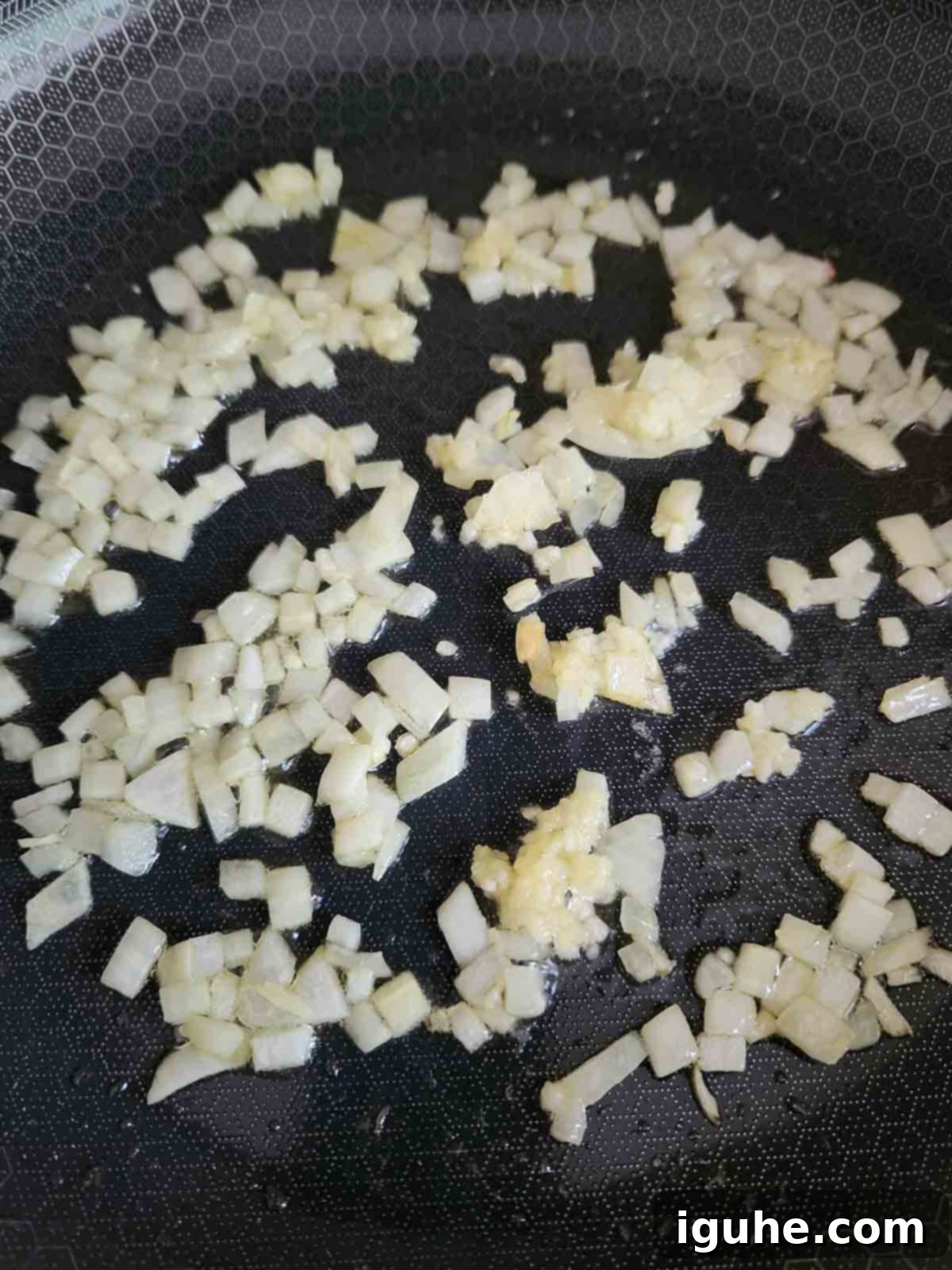
Step 1: Build Your Flavor Base. Begin by heating a tablespoon of extra virgin olive oil in a large skillet over medium heat. Add the chopped yellow onions and sauté them gently for about 4-5 minutes, or until they become beautifully softened and translucent, releasing their natural sweetness. Next, add the minced garlic and continue to sauté for just 30 seconds. It’s crucial not to let the garlic brown, as this can lead to a bitter taste. The goal is to release its aromatic oils.

Step 2: Introduce the Tomatoes. Pour the entire can of whole or crushed tomatoes into the skillet. If you’re using whole tomatoes, use your spoon or a potato masher to break them up directly in the pan. This allows you to control the chunkiness of your sauce, creating a rustic texture that is characteristic of this dish. Stir well to combine the tomatoes with the softened onions and garlic, ensuring all components are integrated.
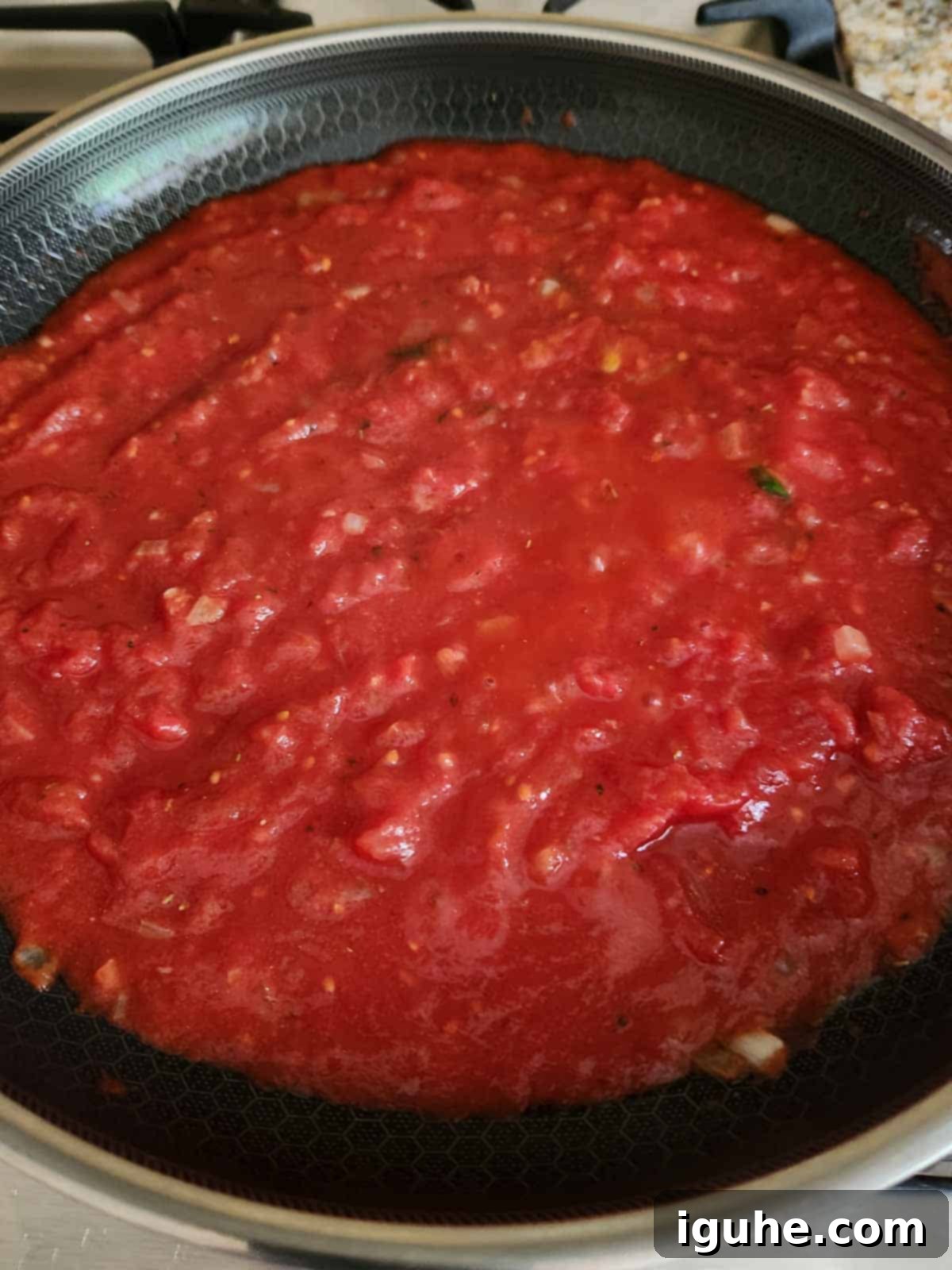
Step 3: Season and Simmer the Sauce. Now it’s time to infuse the sauce with its signature Italian flavors. Stir in the dried oregano, fresh basil, salt, freshly ground black pepper, and if you’re adding a hint of heat, the Calabrian chili paste or crushed red pepper flakes. Give everything a good stir to ensure the seasonings are evenly distributed. Reduce the heat to medium-low and let the sauce gently simmer, uncovered, stirring occasionally. This simmering process is crucial for the flavors to meld and for the sauce to thicken to the perfect consistency.
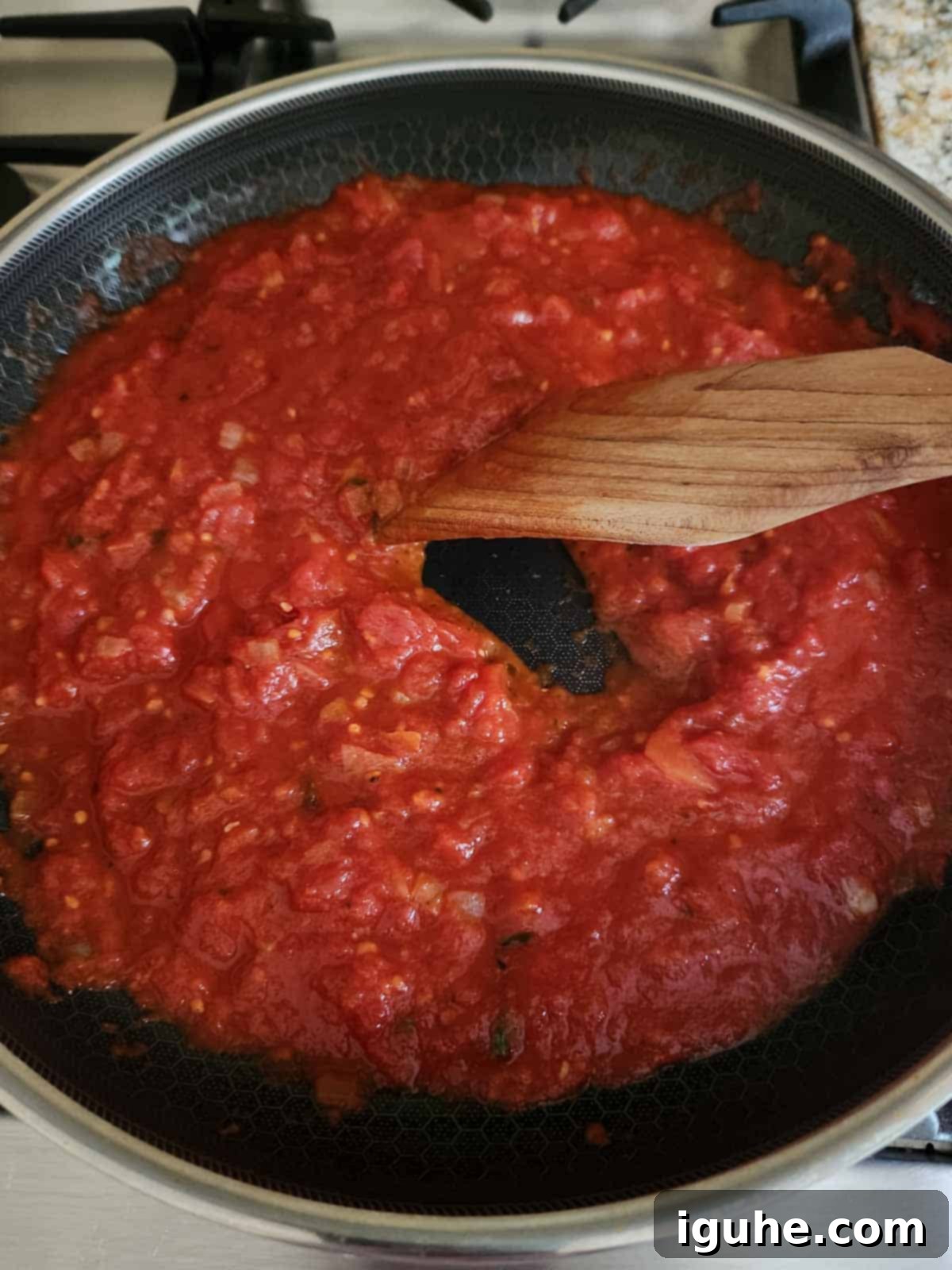
Step 4: Check for Sauce Readiness. To determine if your sauce has reached the ideal thickness, use a spoon or spatula to swipe a path across the bottom of the skillet. If the sauce doesn’t immediately flow back and cover the bottom, it’s ready for the eggs. This visual cue indicates that enough liquid has evaporated, concentrating the flavors and ensuring the eggs won’t be swimming in a watery sauce. Taste and adjust any seasonings as needed before proceeding.

Step 5: Poach the Eggs. Once your sauce is perfectly thickened, use the back of your spoon to create 5-6 shallow wells within the sauce. These indentations will cradle each egg as it cooks. Carefully crack an egg into each well. For best results, crack each egg into a small individual bowl first, then gently slide it into the well. This helps prevent shell fragments and allows for easier placement. Don’t worry if an egg yolk cracks – it will still be delicious! Season the eggs with a pinch of extra salt and pepper.
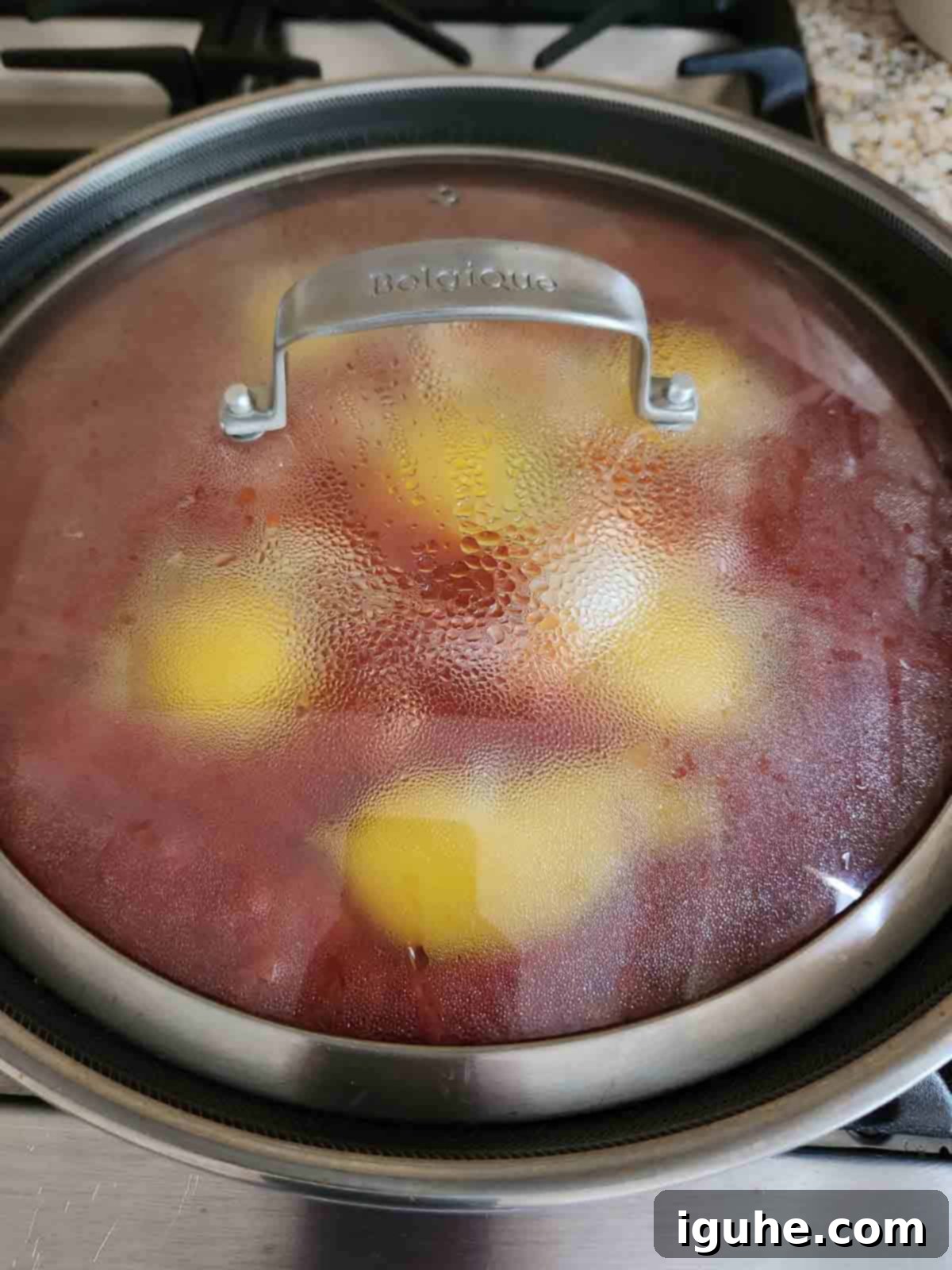
Step 6: Cover and Cook to Perfection. Cover the skillet tightly with a lid. This traps the steam, allowing the eggs to poach evenly and quickly. Continue to cook on low heat for approximately 5-8 minutes, or until the egg whites are fully set but the yolks remain wonderfully runny – or to your preferred level of doneness. Keep an eye on them to achieve your desired consistency. Once cooked, immediately remove from heat and prepare to serve!
*These instructions are a concise summary. For a comprehensive list of directions, including precise measurements and helpful notes, please refer to the recipe card located at the bottom of this page.
👩🍳 Expert Tips for Flawless Eggs in Purgatory
- Choose Whole Tomatoes for Superior Flavor and Texture Control. When selecting canned tomatoes, prioritize whole peeled tomatoes over pre-crushed or diced varieties if possible. Whole tomatoes generally offer a fresher, more intense flavor. Additionally, crushing them yourself in the pan allows you to dictate the sauce’s final texture – from smooth to delightfully chunky – ensuring it perfectly suits your preference and provides a robust base for the eggs.
- Always Crack Eggs into Separate Small Bowls First. This might seem like an extra step, but trust us, it’s a game-changer. Firstly, if you accidentally get any eggshells, they’re much easier to remove from a bowl than from a bubbling pot of sauce. Secondly, it helps prevent any messy spills or splashes directly into your beautifully prepared sauce. Most importantly, preparing each egg in its own small bowl allows you to gently slide them into the wells in the sauce almost simultaneously. This ensures they all start cooking at roughly the same time, preventing the first egg cracked from being overcooked while you’re still working on the last.
- Elevate Your Bread with a Quick Toast. While a fresh, soft loaf of Italian bread is undeniably delicious on its own, taking a few extra minutes to toast it will truly enhance your dining experience. Toasting adds an incredible depth of flavor and a satisfying crunch that contrasts beautifully with the soft eggs and rich sauce. We highly recommend pan-frying slices of bread in a skillet with a drizzle of olive oil until golden brown and crisp. For a more elegant presentation, cut your bread on the diagonal before toasting.
- Master the Sauce Consistency. A perfect “purgatory” sauce should be thick enough to cradle the eggs without being watery, but not so thick that it becomes a paste. If your sauce appears too thin after simmering, simply continue to cook it uncovered, allowing more liquid to evaporate. If it becomes too thick, a splash of water or vegetable broth can help achieve the desired consistency. Remember, it should be thick enough for a spoon to leave a trail before the sauce slowly fills it in.
- Don’t Rush the Simmer. While this is a quick dish, the simmering time for the sauce is crucial. Allowing the tomato sauce to gently bubble, even for just 10-15 minutes, gives the flavors time to meld and deepen. This is where the onions, garlic, and herbs truly infuse into the tomatoes, creating a more complex and satisfying base for your eggs.
Creative Variations for Your Eggs in Purgatory
Eggs in Purgatory is wonderfully adaptable, making it an excellent canvas for culinary creativity. Feel free to customize your sauce with additional ingredients to perfectly suit your taste preferences and whatever you have on hand. These variations can transform the dish into an entirely new experience.
- Boost with More Veggies. Drawing inspiration from its Middle Eastern counterpart, consider sautéing finely diced red or green bell peppers along with the onions in the initial step of preparing your sauce. You can also explore other delicious vegetable additions such as tender peas, diced eggplant, or sliced mushrooms, which add wonderful texture and nutrients. Sauté these until tender before adding the tomatoes.
- Make it Meaty and Hearty. For a more substantial meal, incorporating meat into your sauce is a fantastic option. Brown some ground Italian sausage, pork, or even lean ground turkey with the onions and garlic before adding the tomatoes. The savory notes of the meat will complement the tomato base beautifully, turning it into a truly filling dish.
- Experiment with Herbs and Spices. While oregano and basil are classic, don’t hesitate to play around with other herbs and spices. A pinch of fresh sage can add an earthy aroma, or a touch of smoked paprika could introduce a deeper, smoky flavor profile. Even a tiny hint of cumin could bridge the gap towards a more Shakshuka-like flavor.
- Caponata Eggs in Purgatory: A Sicilian Twist. For an exquisite and flavorful deviation, swap out the traditional tomato sauce in this recipe for a vibrant eggplant caponata. Prepare your favorite Sicilian eggplant caponata, then simply create wells within it and poach your eggs directly in this rich, sweet, and tangy vegetable stew. The combination is absolutely delicious and offers a wonderful depth of flavor.
- Chili Eggs in Purgatory: Unexpected Comfort. Got leftover chili? This might sound unconventional, but it’s a surprisingly comforting and inventive twist! Skip preparing the tomato sauce entirely and instead use your leftover chili as the flavorful base. Heat it gently, create wells, and poach your eggs right in the hearty chili. It’s a fantastic way to repurpose leftovers into a brand-new, satisfying meal.
And if time is of the essence or you’re looking for the ultimate shortcut, remember that you can always use a jar of your favorite store-bought tomato sauce as the base. Simply warm it through, jazz it up with some fresh basil, parsley, and perhaps a pinch of red pepper flakes, then proceed with poaching the eggs. You’ll still have a delicious, speedy brunch on the table in record time!
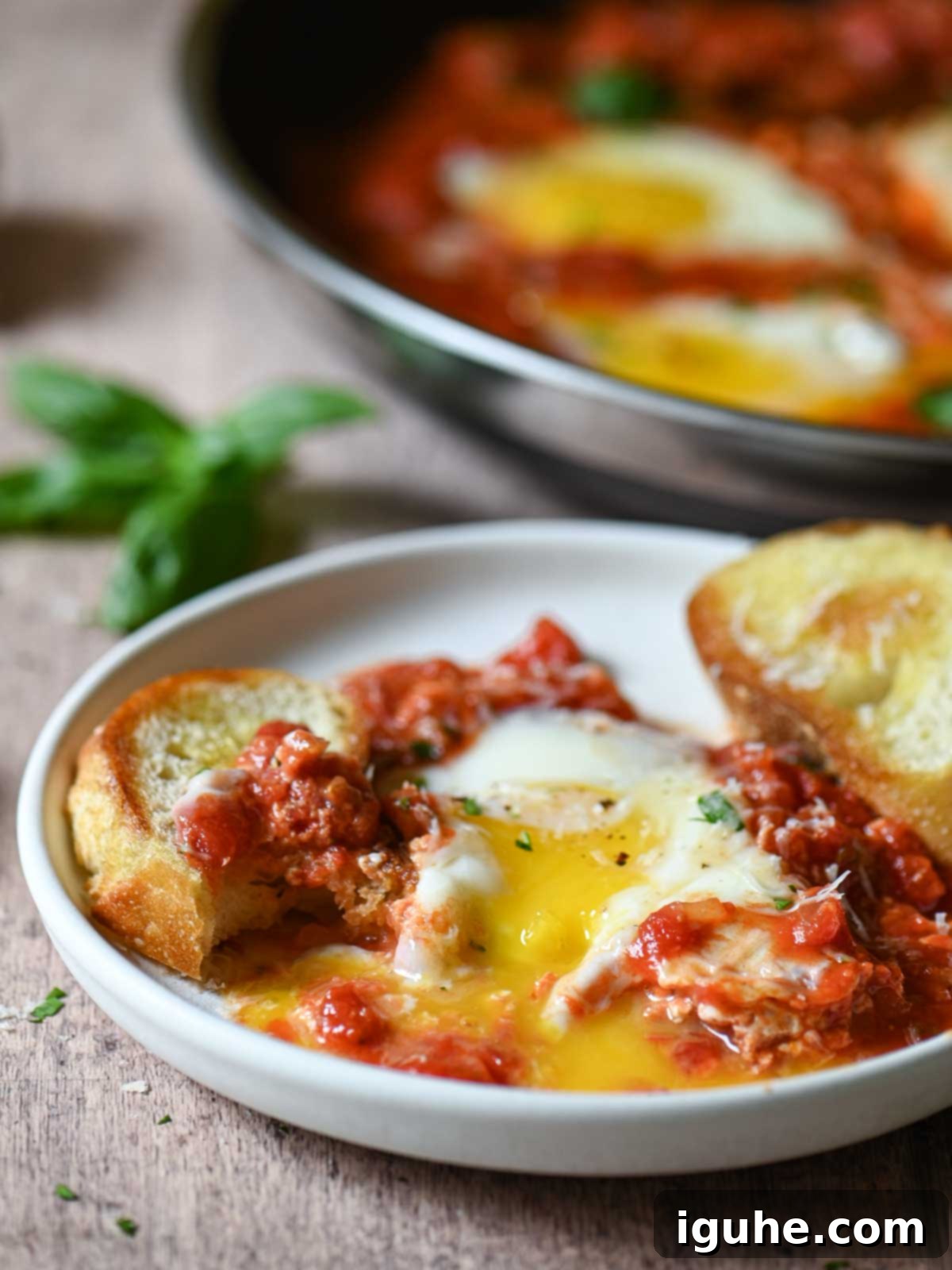
Serving Suggestions: The Art of Dipping and Enjoying
It simply wouldn’t be Eggs in Purgatory without a fantastic, sturdy piece of crusty bread ready for dunking. For those with Italian heritage, like myself, the art of dipping bread into a rich, flavorful sauce is practically a sacred tradition – a skill passed down through generations. It’s not just eating; it’s an experience, a way to savor every last drop of the “eggy, saucy goodness.”
But fear not if you don’t have traditional Italian bread on hand! The goal is a bread that can withstand the sauce and scoop up those delicious yolks. Any sturdy, crusty bread will do the trick: a classic French baguette, a tangy sourdough loaf, soft and pillowy pita bread, naan, focaccia, or even toasted bagels can all serve as excellent vehicles for this dish. Just remember to toast them first for that essential crunch and structure. Honestly, you could probably dunk a potato wedge in there and be happy – the main objective is simply to get dipping and enjoy every morsel!
Beyond the bread, consider a sprinkle of fresh parsley or additional basil for a pop of color and freshness. A dusting of grated Parmesan or Pecorino Romano cheese adds a salty, umami finish that truly elevates the dish. For an extra touch, a drizzle of high-quality extra virgin olive oil over the finished dish just before serving can enhance its aroma and flavor profile. Pair it with a simple green salad dressed with a light vinaigrette for a balanced and complete meal.
Storage & Reheating Tips for Leftover Eggs in Purgatory
While Uova al Purgatorio is undeniably at its best when served fresh, straight from the skillet, any leftovers can be stored and reheated. This dish makes for a convenient and delicious meal prep option for a few days after preparation.
To store, allow the dish to cool completely before transferring it to an airtight container. It can be safely refrigerated for up to 2 days. Keep in mind that when reheated, the eggs will likely cook further, and the yolks may become more firm than when initially served. However, they will still retain their delicious flavor and make for a comforting meal.
For reheating, individual portions can be gently warmed in the microwave until heated through. To prevent splattering and maintain moisture, it’s a good idea to cover the plate with a microwave-safe bowl or lid. Alternatively, you can gently warm the leftovers on the stovetop in a skillet over low heat, adding a tiny splash of water or broth if the sauce seems too thick. Stir the sauce around the eggs to ensure even heating without overcooking the yolks too much. Avoid high heat, which can dry out the sauce and toughen the eggs.

Frequently Asked Questions (FAQ) about Eggs in Purgatory
Absolutely nothing! A watery sauce is a common occurrence and usually indicates that your tomatoes released more liquid than anticipated, or your skillet might be too large, leading to less evaporation during simmering. The solution is simple: just continue to simmer your sauce (without the cover, to encourage evaporation) over medium-low heat until most of the excess water has evaporated and it reaches your desired thickness. The cooking time for the sauce can vary based on several factors, including the type and brand of canned tomatoes you use, and the specific dimensions of your skillet, so trust your eyes and the spatula test!
Yes, absolutely! The tomato sauce base for Eggs in Purgatory can be made 1-2 days in advance and stored in an airtight container in the refrigerator. In fact, many find that the flavors deepen and improve overnight. When you’re ready to serve, simply reheat the sauce gently in the skillet, then proceed with creating the wells and poaching the eggs as instructed.
A large, wide skillet with a lid is ideal. Cast iron skillets work wonderfully as they retain heat beautifully and provide excellent non-stick properties once seasoned. A wide surface area helps the sauce reduce more efficiently and provides ample space to comfortably poach all the eggs without overcrowding. If you don’t have a lid, you can improvise with a baking sheet or foil.
More Cozy & Comforting Recipes to Explore
If you loved the warmth and comfort of Eggs in Purgatory, you’ll surely enjoy these other inviting recipes, perfect for cooler weather or whenever you’re seeking a heartwarming meal.
- Cherry Tomato Confit with Garlic and Thyme
- Baked Brioche French Toast Casserole
- Honeycrisp Applesauce with Brown Sugar and Cinnamon
- Blackberry Boursin Grilled Cheese
Did you make this incredibly flavorful Eggs in Purgatory recipe? We would absolutely love to hear about your experience! Please take a moment to leave a ⭐⭐⭐⭐⭐ rating and a comment right below the recipe card. If you capture a photo of your delicious creation, don’t forget to tag us on Instagram @brunchandbatter. Your feedback helps our community and inspires others to try new recipes!
📖Recipe Card: Eggs in Purgatory (Uova al Purgatorio)

Eggs in Purgatory (Poached Eggs in Tomato Sauce – Uova al Purgatorio)
Equipment
- Large skillet with a tight-fitting lid
- Small bowls or ramekins for cracking eggs (highly recommended for ease)
Ingredients
- 1 tablespoon extra virgin olive oil
- ⅓ cup finely chopped yellow onion
- 2 large garlic cloves, minced
- 1 28-ounce can whole or crushed tomatoes
- ½ teaspoon Kosher salt, plus more to taste
- ¼ teaspoon freshly ground black pepper, plus more to taste
- ¼ teaspoon dried oregano
- ½ teaspoon Calabrian chile paste or spread, or ¼-½ teaspoon crushed red chile flakes, plus more to taste (can omit if you don’t like spice)
- 2 large fresh basil leaves, roughly chopped, plus extra for garnish
- 5-6 (any size) fresh eggs
- 1 tablespoon chopped fresh parsley for topping
- Grated Parmesan or Pecorino Romano cheese for topping (optional)
- Crusty Italian or French bread, for serving (toasted)
Instructions
- In a large skillet, heat the extra virgin olive oil over medium heat. Add the chopped yellow onions and sauté, stirring occasionally, until they are softened and translucent, about 4-5 minutes. Stir in the minced garlic and cook for an additional 30 seconds, being careful not to let it brown, which can make it bitter.1 tablespoon extra virgin olive oil, ⅓ cup chopped yellow onion, 2 large garlic cloves, minced
- Add the canned tomatoes to the skillet. If using whole tomatoes, use your spoon or a potato masher to break them up into smaller, rustic chunks directly in the pan. Stir in the Kosher salt, freshly ground black pepper, dried oregano, chopped fresh basil, and the Calabrian chile paste or crushed red pepper flakes (if using for spice). Reduce the heat to medium-low and let the sauce gently simmer, uncovered, until it has thickened to your desired consistency. Stir occasionally to prevent sticking. You’ll know the sauce is ready when you can swipe your spatula across the bottom of the skillet, and the sauce doesn’t immediately flow back to cover the exposed area. Taste the sauce and adjust seasonings as needed, adding more salt, pepper, or spice to your preference.1 28-ounce can whole or crushed tomatoes, ½ teaspoon Kosher salt, plus more to taste, ¼ teaspoon freshly ground black pepper, plus more to taste, ¼ teaspoon dried oregano, ½ teaspoon Calabrian chile paste or spread, or ¼-½ teaspoon crushed red chile flakes, plus more to taste, 2 large fresh basil leaves, chopped, plus more for garnish
- Prepare your eggs. For the cleanest results, crack each egg into a small individual bowl or ramekin. This optional step makes it easier to prevent shells from entering the sauce and allows for simultaneous cooking. Create 5-6 shallow wells in the thickened tomato sauce, ensuring they are evenly spaced around the perimeter and center of the skillet. Gently slide one egg into each well. Season the eggs lightly with additional salt and pepper. Cover the skillet tightly with its lid and cook the eggs on low heat for approximately 5-8 minutes, or until the whites are fully set and the yolks are still wonderfully runny (or cooked to your desired firmness).5-6 (any size) eggs, 1 tablespoon chopped fresh parsley for topping
- Serve your Eggs in Purgatory immediately. Garnish generously with additional fresh basil, chopped fresh parsley, and a dusting of grated Parmesan or Pecorino Romano cheese, if desired. This dish is incomplete without slices of toasted crusty Italian or French bread, perfect for dipping into the rich sauce and runny yolks.grated Parmesan or Pecorino Romano cheese for topping, Italian or French bread for serving, toasted
Notes
- Whole tomatoes are more flavorful. For the best flavor and texture, opt for canned whole tomatoes instead of crushed or diced ones. Crushing them yourself allows you to control the sauce’s consistency, from chunky to smoother.
- Crack your eggs into little bowls first. This simple tip saves you from fishing out shells and ensures a cleaner, more organized process. It also helps you add all eggs to the sauce at roughly the same time, promoting even cooking.
- Always toast your bread. While fresh bread is good, toasting your bread (especially in a skillet with a little olive oil) adds an irresistible crunch and depth of flavor that perfectly complements the soft eggs and rich sauce. Cut on the diagonal for a lovely presentation.
Nutrition*
*Nutrition information is provided as a courtesy and is an estimate only. Nutritional content can vary significantly based on specific product brands, exact measurements, and substitutions made. Therefore, it is always recommended that you perform your own nutritional calculations for your finished recipe if precision is required.
